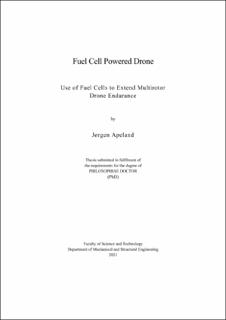| dc.contributor.advisor | Pavlou, Dimitrios | |
| dc.contributor.advisor | Hemmingsen, Tor | |
| dc.contributor.author | Apeland, Jørgen | |
| dc.date.accessioned | 2021-10-05T12:24:39Z | |
| dc.date.available | 2021-10-05T12:24:39Z | |
| dc.date.issued | 2021-10 | |
| dc.identifier.citation | Use of Fuel Cells to Extend Multirotor Drone Endurance by Jørgen Apeland, Stavanger : University of Stavanger, 2021 (PhD thesis UiS, no. 605) | en_US |
| dc.identifier.isbn | 978-82-8439-028-4 | |
| dc.identifier.issn | 1890-1387 | |
| dc.identifier.uri | https://hdl.handle.net/11250/2787738 | |
| dc.description | PhD thesis in Mechanical and Structural Engineering | en_US |
| dc.description.abstract | Unmanned aerial systems can be used for a range of industrial applications to reduce risk, cost, and time. Fuel cell-based propulsion systems are outlined as a solution to extend mission endurance, one of the current main barriers for further adoption. This coincides with a general societal push towards more sustainable aviation and the use of fuel cells and hydrogen as important zero-emission enablers.
In this thesis, results from research about the use of fuel cells to extend multirotor drone flight endurance are presented. This application entails certain challenges compared to fixed-wing drones, which has been the scope of most previous research. The research explores the performance threshold between batteries and a fuel cell-based propulsion system, the prospects of further adoption, and how the performance can be improved.
A prototype fuel cell system is developed and integrated into an X8 multirotor drone with a take-off mass of 21 kg and flight-tested. The specific energy on a power plant level was 243 Wh/kg, and the gross endurance for the current system is estimated to be 76 minutes, a 90% increase from the comparable endurance of the battery-powered alternative. The performance of the 2 kW fuel cell hybrid system is characterized in laboratory testing and exposed to relevant load profiles with a peak load of 2.8 kW.
This is one of few independent third-party multirotor drone integrations of a fuel cell-based propulsion system. Based on experimental data from laboratory testing and full-scale flight in a realistic operating environment, a unique overview of associated challenges and further work is provided. As there is little published research on this topic, the work should be valuable for the research community, as well as drone operators and technology providers. | en_US |
| dc.language.iso | eng | en_US |
| dc.publisher | University of Stavanger, Norway | en_US |
| dc.relation.ispartofseries | PhD thesis UiS; | |
| dc.relation.ispartofseries | ;605 | |
| dc.relation.haspart | Paper 1: J. Apeland, D. Pavlou, and T. Hemmingsen, "State-of- Technology and Barriers for Adoption of Fuel Cell Powered Multirotor Drones," in 2020 International Conference on Unmanned Aircraft Systems (ICUAS), Athens, Greece, 2020, pp. 1359-1367, DOI: 10.1109/ICUAS48674.2020.9213971. In reference to IEEE copyrighted material which is used with permission in this thesis, the IEEE does not endorse any of University of Stavanger's products or services. Internal or personal use of this material is permitted. If interested in reprinting/republishing IEEE copyrighted material for advertising or promotional purposes or for creating new collective works for resale or redistribution, please go to http://www.ieee.org/publications_standards/publications/rights/rights_link.html to learn how to obtain a License from RightsLink. | en_US |
| dc.relation.haspart | Paper 2: J. Apeland, D. Pavlou, and T. Hemmingsen, "Suitability Analysis of Implementing a Fuel Cell on a Multirotor Drone," Journal of Aerospace Technology and Management, vol. 12, e3220, 2020, DOI: 10.5028/jatm.v12.1172. | en_US |
| dc.relation.haspart | Paper 3: J. Apeland, D. Pavlou, and T. Hemmingsen, "Sensitivity Study of Design Parameters for a Fuel Cell Powered Multirotor Drone," Journal of Intelligent & Robotic Systems, vol. 102, p. 6, 2021, DOI: 10.1007/s10846-021-01363-9. | en_US |
| dc.rights | Copyright the author | |
| dc.subject | droner | en_US |
| dc.subject | drivstoffceller | en_US |
| dc.title | Use of Fuel Cells to Extend Multirotor Drone Endurance | en_US |
| dc.type | Doctoral thesis | en_US |
| dc.rights.holder | ©2021 Jørgen Apeland | en_US |
| dc.subject.nsi | VDP::Teknologi: 500 | en_US |
